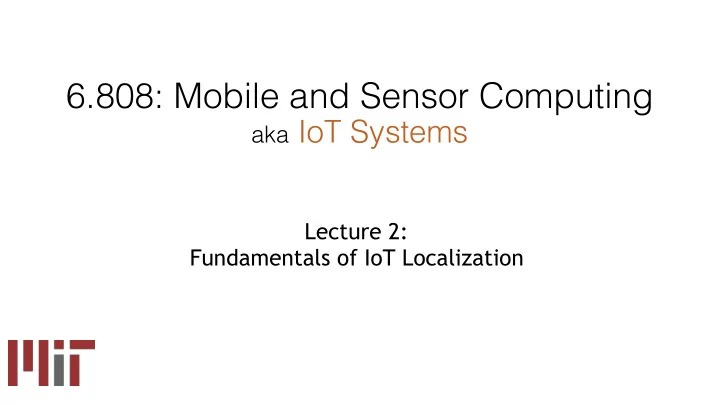

6.808: Mobile and Sensor Computing aka IoT Systems Lecture 2: Fundamentals of IoT Localization
What is Wireless Positioning (aka Localization)? The process of obtaining a human or object’s location using wireless signals Applications: • Navigation: both outdoors (GPS) and indoors (e.g., inside museum) • Location based services: Tagging, Reminder, Ads • Virtual Reality and Motion Capture • Gestures, writing in the air • Behavioral Analytics (Health, activities, etc.) • Locating misplaced items (keys) • Security (e.g., only want to give WiFi access to customers inside a store) • Delivery drones
What are the different ways of obtaining location? • Radio signals: GPS, Cellular, Bluetooth, WiFi • Ultrasound signals: similar to those used in NEST • Inertial • Cameras, Vision, LIDAR Focus of this lecture We will discuss the localization techniques in increasing order of sophistication
Who performs the localization process? •Device based: A device uses •Network based: Anchors (or incoming signal from one or Access points) use the signal more “anchors” to determine coming from device to its own location determine its location • Example: Radar • Example: GPS
1) Identity-based Localization Idea: Use the identity and known location of anchor nodes Example: • Wardriving -- been used to improve the accuracy of GPS • WiFi indoor localization Localize by mapping to one of those locations. Pros? Cons?
2) Received Signal Strength (RSSI) Idea: Higher power -> closer; lower power-> further In fact, we can extract more information about exact distance from measured power. Need to understand more about wireless signals
Wireless Signals are Waves Amplitude decays d Receiver Transmitter phase rotates Channel equation (Complex number) Wavelength λ
Wireless Signals are Waves Channel equation (Complex number) Imaginary Real
2) Received Signal Strength (RSSI) From power to distance Power is proportional to 1/d 2 P (received) distance
2) Received Signal Strength (RSSI) Trilateration from Distance Measurements (x1,y1) d1 (x,y) Pros? Cons?
2) Received Signal Strength (RSSI) From power to distance Power is proportional to 1/d 2 Con 1: Small change in power P (received) leads to large deviations in distance at larger distances distance
2) Received Signal Strength (RSSI) From power to distance Power is proportional to 1/d 2 Con 2: Multipath: Due to P (received) reflections, get constructive and destructive interference (equation) distance
2) Received Signal Strength (RSSI) Solution: Fingerprinting i.e., measuring device records signal strength fingerprints at each location Pros? Cons?
3) Use the Signal “Phase” Phase d Receiver Transmitter phase rotates Wavelength λ Pros? Cons?
4) Use Angle of Arrival (AoA) Triangulation from Angular Measurements Measure Angle of Arrival (AoA) from device to each AP 𝜄 2 𝜄 1
4) Use Angle of Arrival (AoA) Triangulation from Angular Measurements How can we obtain the angle? s Issues? Rx1 Rx2
4) Use Angle of Arrival (AoA) Triangulation from Angular Measurements Use Antenna Arrays s … Rx1 Rx2 Rx3 Rx4 RxN
4) Use Angle of Arrival (AoA) Triangulation from Angular Measurements Use Antenna Arrays 90 o 120 o 60 o 150 o 30 o 180 o 0 How do we know which direction corresponds to the direct path?
5) Measure the Time-of-Flight (ToF) time of flight (travel) Receiver Transmitter Transmitter Distance = Time of flight x speed of travel Can use trilateration (intersection circles/spheres) How do we know when the signal was transmitted?
6) Time-difference-of-arrival (TDoA)
State-of-the-Art Techniques? • Sophisticated Combinations of these techniques, e.g.,: • Combine AoA with time-of-flight • Use circular antennas and combine with inertial sensing • Perform synthetic aperture radar and DTW • Synthesize measurements from multiple frequencies • …
Recommend
More recommend